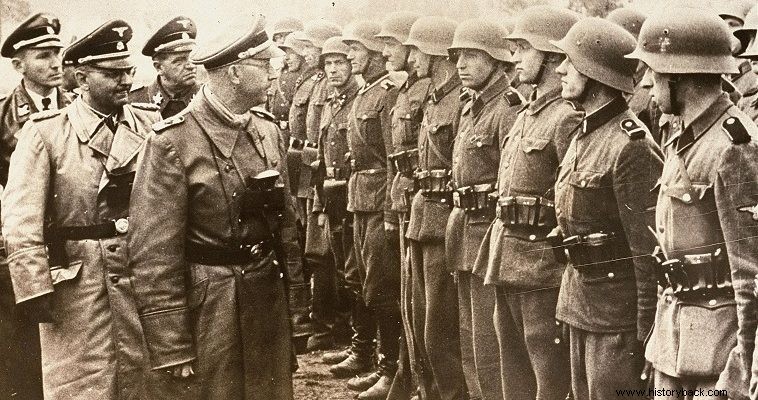
On June 22, 1941, German forces invaded the Soviet Union. Within no time they had advanced deep into the Soviet hinterland. And in the late summer and early fall of 1941, after the disastrous battles for Soviet weapons in Uman and Kyiv, the Germans occupied most of Ukraine.
The populations living there, belonging to various nationalities, welcomed the Germans in most cases with bread and salt (a traditional way of welcoming a welcome guest).
The Germans in Ukraine
The Germans, although they considered the Ukrainians "subhuman", nevertheless exploited those willing to cooperate, at least as long as it suited them (case Stepan Bandera ). However, even before the start of Operation Barbarossa, at least 4,000 Ukrainians served in the Wehrmacht and were the ones who led the German troops in the first phase of the operation.
Parts of what used to be south-eastern Poland (Podolia), apart from Crimea, which was occupied in its entirety in 1942, also came under German Ukraine. The western Ukrainians were a mixture of ethnicities - Poles, Galicians, Cossacks - who, due to historical circumstances, had never acquired, in fact, a specific national consciousness, passing, at regular intervals, under the rule of the Roman Catholic Poles, the Orthodox Russians, or the Muslim Turks.
The Poles were Roman Catholic, in religion, while the Cossacks were Orthodox, the Tatars were Muslim and the Galicians, the great majority in other words, were Greco-Rhythm, the so-called Unites, who followed the Orthodox standard, but were under the jurisdiction of the Vatican.
In this country with a deep ethnic and religious division, the Germans dominated easily because in a part of it the Soviet power had not had time to consolidate - areas that came under Soviet control in 1939, by virtue of the Ribbentrop - Molotov Pact - while in the rest of the areas, with the exception those of the Cossacks, existed, literally, against the Russians and the Jews, who, taken together, represented in the eyes of the inhabitants the hated Soviet power, which caused them great suffering – famine, pestilence, collectivization.
So they consciously sided with the Germans. The latter, with the support of the western Ukrainians, started, in principle, the persecution against the Jews, exterminating tens of thousands of them, aided by the Ukrainians. A typical example of cooperation is the horrific massacre in Babi Yar, in 1941, where tens of thousands of Jews were murdered.
“Police” battalions
Ukrainian nationalist organizations collaborated with the Germans. According to modern studies by Harvard University, a large number of men and executives of these organizations either served in the "Ukrainian Police Battalions" formed by the Germans, with the purpose of controlling the country and hunting Jews, or were trained as spies for to operate behind Soviet lines, whether they trained and served as guards in the extermination camps of Treblinka, Sobibor and Belcek. In these camps all the guards were Ukrainians, with very few Germans in charge.
As for the Police Battalions, seven were officially established, but their number gradually increased. These battalions participated in German counter-insurgency operations and their men were responsible for thousands of civilian deaths. The 118th Police Battalion, for example, burned alive all the inhabitants of the village of Katyn, Belarus – where Stalin exterminated the Polish officers.
14th SS Volunteer Division
At the same time, special units were organized which served normally in the ranks of the German Army, such as the Nachtigal Battalion, the Roland Battalion, the 3rd Volunteer Regiment, the 4th Volunteer Regiment. A highlight of Ukrainian participation was the formation of the 14th Waffen SS Galizien (Galicia) Volunteer Division. When the Germans asked for volunteers to man her, more than 80,000 showed up, mainly Galician Unites!
Eventually 13,000 men were assigned to this division. The Germans allowed the Ukrainian soldiers to have military chaplains with them – a unique privilege for an SS unit. The division had three infantry regiments (29th, 30th and 31st), the 14th Fusilier Battalion (light motorized reconnaissance battalion), an artillery regiment, an engineer battalion, a transport battalion and services .
The division changed its title several times. It was originally called the SS Volunteer division, then the 1st SS Grenadier Division “Galicia”, then the 1st SS Grenadier Division “Ukraine” and finally the 1st Division of the Ukrainian National Army.
In July 1944 the division was destroyed in the Battle of Brody . However, he reorganized and arrived, fighting in favor of the Germans, as far as Slovakia, where he acted against the Slovaks who rebelled against the Germans. He was later sent to Slovenia and eventually went to Austria where he fought against the Soviets until mid-April 1945.
In addition to the division, the Germans also formed five other Galician infantry regiments, which are responsible for many and brutal deaths of Poles, mainly civilians, for burning entire villages, looting and looting.
